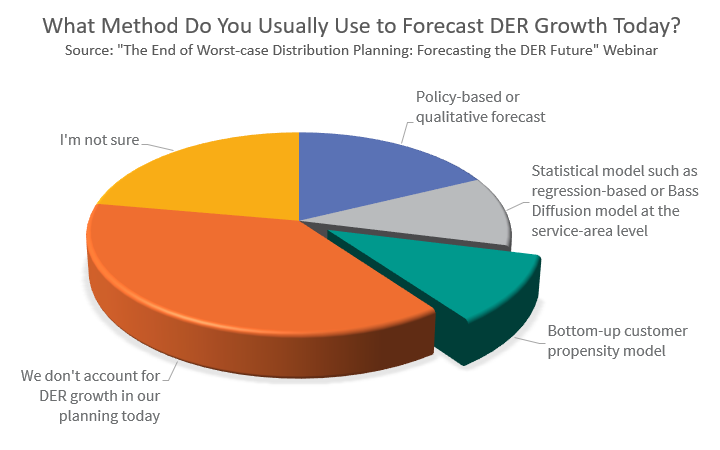It’s impossible to know exactly what DER technologies will be selected by customers, where they will be connected and how they will be used. Because there is so much uncertainty in both the adoption and operation of DERs, traditional deterministic planning methods built around a worst-case don’t work. The set of possible outcomes is very large, and the probability and consequence of each should be considered.
At our recent webinar “The End of Worst-case Distribution Planning: Forecasting the DER Future,” we polled the audience on several topics. We expected to see a variety of approaches to DER adoption planning among audience members. However, we were surprised that 38% currently are not accounting for DER growth at all, and another 22% aren’t sure if or how they are. Of the 40% that are forecasting DER growth today, most are using policy-based, qualitative or service-area level approaches.

In the webinar, the Sacramento Municipal Utility District (SMUD), Opus One Solutions and Clean Power Research discuss innovative strategies and techniques to move beyond worst-case planning for DERs, including:
- Improved planning with customer-level DER forecasting
- Comparison of traditional and non-wires alternatives
- Execution of comprehensive hosting capacity analysis
Here are some key takeaways from the webinar:
- For years, forward-thinking utilities such as SMUD have been forecasting DER adoption, yet still consider themselves to be at an early stage when it comes to using information from adoption forecasts across the utility business.
- When planning for DERs, there are an extremely large number of scenarios and violations to be considered. Understanding the full range of possible outcomes—not just the worst-case scenario—is the first step toward confident evaluation of non-wires alternatives.
- Not only are there an extremely large number of scenarios, it’s impossible to forecast exactly which scenario will occur. Unlike deterministic worst-case planning, the use of probabilistic forecasting allows for assessment of the full range of possible outcomes.
Customer-level DER adoption forecasts
Moving away from worst-case planning is a daunting task for utilities that have used traditional approaches for decades. One way to get started is to implement a bottom-up DER adoption propensity model such as the one available in WattPlan® Grid. Customer-level adoption forecasting provides valuable insights today, such as:
- Feeder-level load shapes including impact of DERs
- System-level DER adoption
- Customer propensity to adopt DERs
Customer propensities can inform probabilistic planning whenever the utility is ready.
DER adoption forecasts are only as good as their input data. Utilities can leverage data they already have to improve bottom-up DER adoption forecasts. For those utilities using PowerClerk® as a DER system of record, or offer WattPlan® to its customers, data is easily made available to WattPlan Grid. WattPlan Grid also uses industry-leading SolarAnywhere® irradiance data in the customer-level bill calculations modeled in the DER adoption forecast.
To leave worst-case distribution planning behind and reap the full benefits of a probabilistic approach, advanced distribution analysis capability such as Opus One Solutions’ GridOS is another critical piece of the puzzle.
Interested in diving deeper? We invite you to watch the webinar “The End of Worst-case Distribution Planning: Forecasting the DER Future” to learn more.
